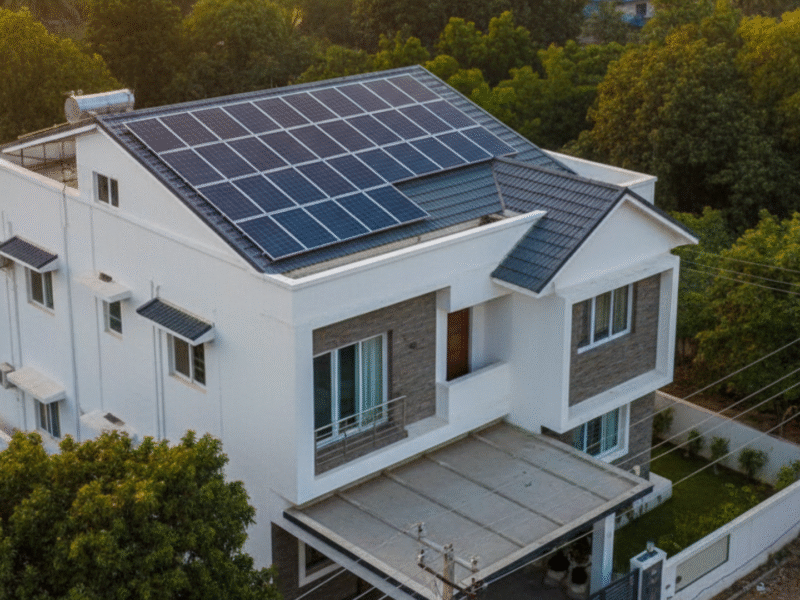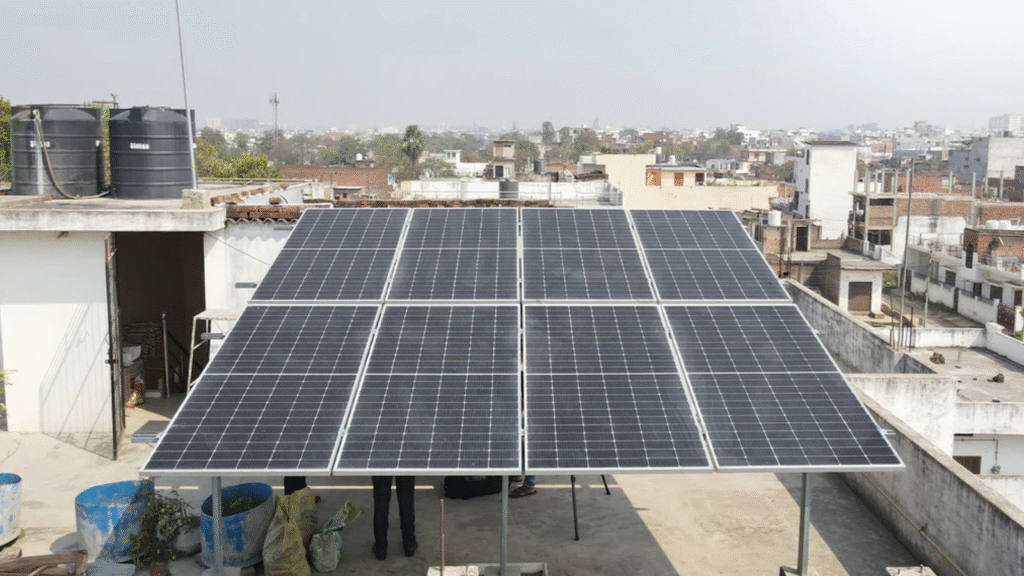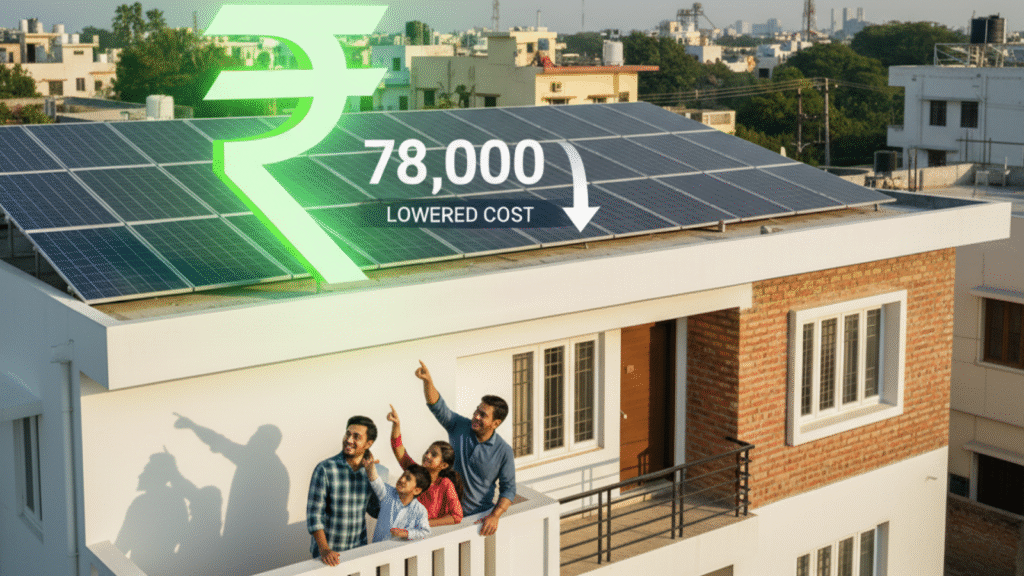
Going solar has never been more financially smart, but understanding the true on-grid solar system pricing requires looking beyond the sticker price. For homeowners and businesses considering a grid-tied system in India, 2025 is a particularly pivotal year due to evolving subsidy structures and technological advancements.
This guide is designed to provide you with a clear, comprehensive breakdown of residential and commercial on-grid solar system pricing in the current Indian market, helping you make a confident, well-informed decision.
Understanding the Average On-Grid Solar System Pricing in 2025

The cost of an on-grid solar system in India is usually quoted in Rupees. This figure helps in comparing quotes and calculating the final investment after considering the Central Government Subsidy.
Residential On-Grid Solar System Cost by Size (After Central Subsidy)
Prices are indicative and can vary based on your city, system size, and components. Here is an estimated breakdown with and without the Central Government Subsidy for grid-tied rooftop solar in 2025:
| System Size | Price Without Subsidy* | Central Subsidy | Price With Subsidy* |
| 2 kW | ~ Rs. 1,75,000 | Rs. 60,000 | ~ Rs. 1,15,000 |
| 3 kW | ~ Rs. 2,05,000 | Rs. 78,000 | ~ Rs. 1,27,000 |
| 4 kW | ~ Rs. 2,50,000 | Rs. 78,000 | ~ Rs. 1,72,000 |
| 5 kW | ~ Rs. 2,95,000 | Rs. 78,000 | ~ Rs. 2,17,000 |
*Disclaimer: Prices are indicative and subject to change based on location, system components, vendor, and other factors. Subsidy amounts are based on current Central Government schemes and regulations.
Commercial On-Grid Solar System Price Estimate (for High Capacity)
Commercial solar pricing in India, often for systems above 10 kW, benefits from economies of scale.
- Average Commercial Price Per Watt (Unsubsidized): Typically ranges from Rs. 40 to Rs. 60/W depending on the scale and equipment.
- Commercial systems may have different eligibility for central and state subsidies or financing options compared to residential.
The Single Biggest Factor in On-Grid Solar System Pricing: Government Subsidy

The Central Government Subsidy is the most significant factor that reduces the net cost of your system—what you actually pay out of pocket.
Calculating the Central Government Subsidy
The subsidy structure is designed to encourage adoption, particularly for smaller residential systems:
- 1-3 kW Systems: Receive a fixed subsidy amount (as shown in the table).
- 4 kW and Above: The subsidy is capped at the maximum limit for 3 kW, which is why the amount remains constant for 4 kW and 5 kW systems.
- The PM Surya Ghar Muft Bijli Yojana: This is the current key scheme, offering substantial financial assistance to residential consumers.
State-Specific Incentives and Net Metering
Beyond the Central Subsidy, your total on-grid solar system pricing and long-term savings are heavily influenced by state-level policies:
- State Nodal Agencies: They manage the subsidy disbursement and may offer additional incentives or tax benefits.
- Net Metering: This crucial policy allows you to feed excess solar energy back to the grid, dramatically reducing your monthly electricity bills and ensuring a higher return on investment.
Key Factors That Drive Your Final On-Grid Solar System Pricing

The total cost is a sum of equipment, labor, and soft costs. Several variables can push your price-per-watt up or down.
Equipment Quality and Type
The components you choose directly impact the total on-grid solar system price in India:
- Solar Panels: Tier-1, high-efficiency panels (Monocrystalline PERC or Bifacial) will be more expensive upfront but offer better performance and reliability.
- Inverters: Choose between string inverters (cost-effective) and hybrid/micro-inverters (better performance with shading, higher initial cost).
- Installation Standard: Ensure the installer uses quality structures, cables, and earthing, which accounts for a significant portion of the total cost.
Installation Complexity and Labor Costs
Your project’s “soft costs”—labor, permitting, and inspection—form a large part of the on-grid solar system pricing.
- Roof Type: Installations on flat roofs (where most Indian residential solar happens) need custom elevated structures, which can increase the cost.
- Local Permitting: Getting approvals from the DISCOM (Distribution Company) takes time and money, and the process varies significantly by state.
Calculating Your Solar Return on Investment (ROI)

The true measure of a good solar deal isn’t the upfront cost, but the long-term value.
The Payback Period for On-Grid Systems in India
The solar payback period is the time it takes for your electricity bill savings and subsidies to equal your net system cost.
- Average Payback: In India, with subsidies, residential solar systems typically see a payback period of 4 to 6 years.
- Factors to Shorten Payback: High electricity consumption and strong Net Metering policies will significantly shorten this period.
Lifetime Savings in Rupees
Most solar panels come with a 25-year performance warranty. After your system is paid off, the electricity generated is essentially free. Over 25 years, a well-maintained 5 kW system can generate Rs. 5,00,000 to over Rs. 10,00,000 in electricity bill savings, depending on the inflation of utility rates.
Conclusion: Securing the Best On-Grid Solar System Pricing in 2025
The definitive on-grid solar system pricing for your property depends on system size, quality components, and how well you leverage the full Central Government Subsidy. With current schemes and a clear path to high savings, 2025 is an excellent time to invest.
Don’t miss the opportunity to significantly reduce your electricity bills. Request customized, no-obligation quotes today to lock in your best 2025 on-grid solar system price.
Frequently Asked Questions (FAQs) on On-Grid Solar System Pricing
Q: What is the average price range for a 5kW On-Grid solar system with subsidy in 2025?
A: Based on current trends and Central Subsidy, a 5 kW system typically costs around Rs. 2,17,000 after subsidy, but this is indicative and location-dependent.
Q: Does “On-Grid” mean I get electricity during a power cut?
A: No. A pure On-Grid solar system automatically shuts down during a grid power outage (for safety reasons). To get backup power, you must install a Hybrid system with a battery, which increases the initial on-grid solar system pricing.
Q: How is the subsidy calculated for systems larger than 3 kW?
A: For residential systems currently under the PM Surya Ghar scheme, the subsidy caps at the amount offered for a 3 kW system (Rs. 78,000 in the provided table). The subsidy does not increase for systems of 4 kW or 5 kW.
Q: What is the main benefit of Net Metering?
A: Net Metering allows you to receive credit for any extra electricity your solar panels generate and push back into the main grid. This is a critical factor for achieving a quick payback period for your system.

